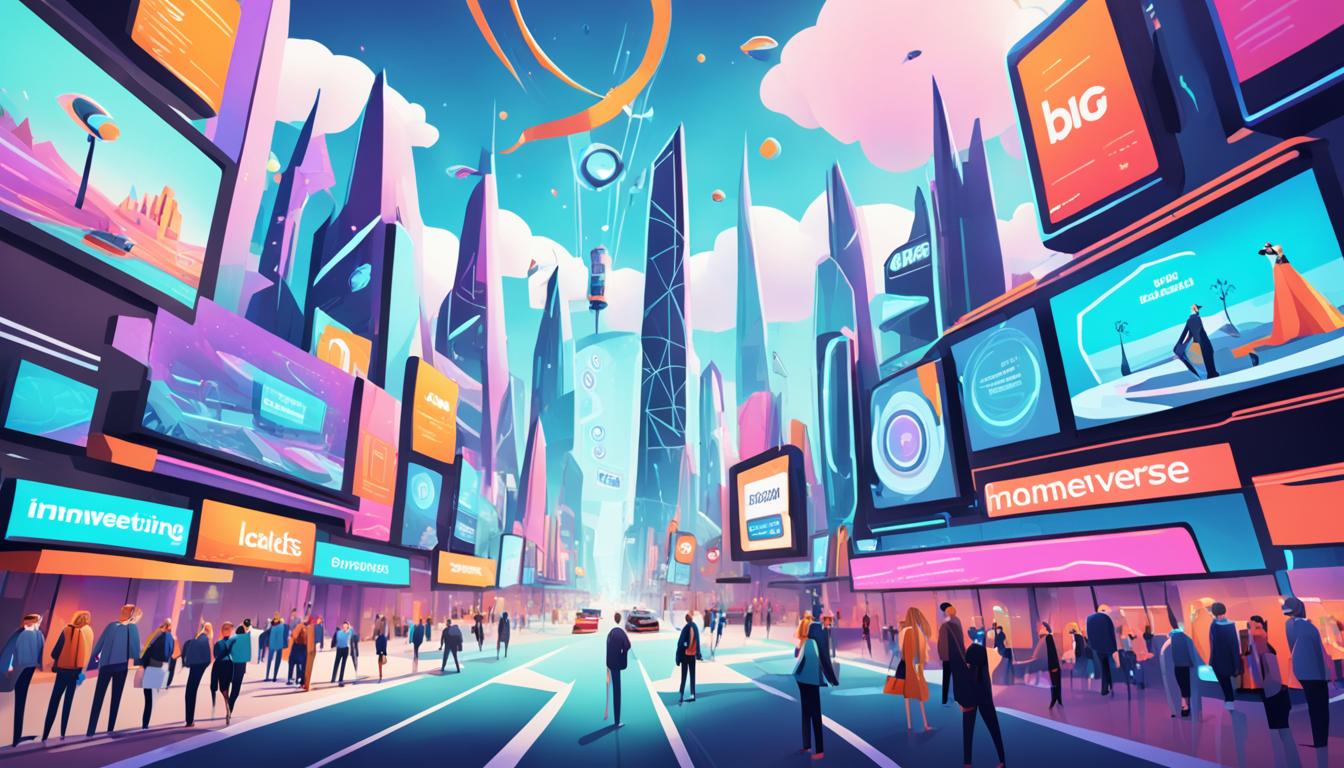Digital Marketing in the Metaverse: Opportunities and challenges.
Did you know that Roblox, a leader in the metaverse, has 200 million active users? These users spent a huge $319 million on in-game currency in just one quarter of 2020. This shows how big the shift to digital marketing in the metaverse is.
The metaverse is becoming real, blending our physical and virtual worlds. It started with Neal Stephenson’s idea in 1992. Now, big names like Meta (formerly Facebook), Google, and Microsoft are making it real. They’re creating immersive experiences that mix our digital and real lives.
For marketers, the metaverse is a new playground for engaging campaigns. Imagine using virtual reality for branded events or augmented reality for product demos. It lets brands reach people in new ways, through new channels.
But, there are challenges ahead. Things like getting people to use it, technical issues, privacy worries, and ethical questions are big hurdles. Marketers need to be quick, creative, and careful to succeed in this new digital world.
Key Takeaways
- Businesses can use VR and AR to connect with consumers better.
- Immersive brand experiences change how people see brands.
- NFTs are a new way to show digital ownership and value.
- Building virtual communities helps build brand loyalty and engagement.
- Technical and privacy issues are big challenges in metaverse marketing.
We’ll look more into the chances and challenges of digital marketing in the metaverse. We’ll talk about VR/AR marketing, immersive brand experiences, NFTs, and building communities. Stay with us as we explore this exciting digital world.
Introduction to the Metaverse
The metaverse is more than just a buzzword; it’s a new virtual world where digital and real worlds blend. It uses VR, AR, and fast internet to make experiences feel real. Big names like Meta, Google, and Microsoft are racing to be part of it, seeing big chances for making money and engaging with people. For businesses, understanding this space is key to making a strong Metaverse strategy.
What is the Metaverse?
The metaverse is a mix of online worlds where people can hang out, work, and have fun. It offers experiences that go beyond just chatting online. For instance, Gucci’s metaverse store on Roblox drew in 19.9 million visitors in two weeks, showing how immersive experiences can attract a lot of attention. Brands like Vans and Chipotle have also seen huge success, pulling in millions of users and boosting their brand.
History and Origin of the Metaverse
The word “metaverse” was first used by Neal Stephenson in his 1992 book Snow Crash. It described a future where people interacted in a 3D virtual space as avatars. Since then, it has grown in popularity, with internet searches for it jumping by 7,200% in 2021. Companies like Epic Games have raised a lot of money to build these virtual worlds.
Now, businesses are selling products directly to avatars, showing how they’re using virtual spaces for unique sales. This market has grown to a whopping $54 billion.
Virtual Reality and Augmented Reality Marketing
Virtual reality marketing and AR advertising are changing how brands talk to their audience. Big names like Meta, Google, and Microsoft are investing a lot in the Metaverse. This means more chances for immersive experiences.
Potential of VR and AR in Marketing
VR and AR can really change marketing. VR lets people dive into fully immersive worlds. This means they can try out products and see places in a new way, which helps them understand and connect with brands better.
AR, on the other hand, blends the digital and real worlds. It shows products in real-time and lets people interact with ads. This makes shopping and advertising more fun and engaging.
Retailers use AR to let customers see products at home, which helps sell more. Real estate agents use it for virtual tours, making it easier for clients to decide on properties. These examples show how VR and AR can boost engagement and profits.
Examples of Successful VR and AR Campaigns
Companies are now using VR and AR to make memorable campaigns. Nike’s “Nikeland” on Roblox is a great example. It’s a virtual world that helps increase brand awareness and brings in new money.
Another example is Gucci’s experience on Roblox. It combined digital and real elements for a unique level of interaction.
AR campaigns are also a hit. Retailers use AR in stores so customers can see how products fit their spaces or try them out before buying. This approach boosts customer happiness and sales.
For AR to be widely used, it needs to work well on different devices. Brands should focus on creating experiences that work across various platforms. This way, they can reach more people, engage them better, and keep them coming back.
Immersive Brand Experiences in the Metaverse
Immersive brand experiences in the metaverse make a big impact. They help brands connect deeply with consumers. Marketers use this new space to make their brands stand out with cool visuals and fun interactions.
Creating Engaging Virtual Spaces
Creating these experiences takes careful planning and action. For instance, Aquent built a huge metaverse world for its team, clients, and talent. They went through research, inspiration, design, and optimization to make a space that pulls people in.
Aquent picked Spatial for its wide reach. Their Pavilion hosted events and showed off skills in things like 3D design and making real-life experiences. They mixed brand rules with new ideas, trying out different looks and feels to stand out. This helped Aquent build connections and team up with its people.
Case Studies of Immersive Brand Campaigns
Some campaigns show how well immersive brand experiences work. Hyundai’s Mobility Adventure on Roblox is a hit with users, thanks to its interactive stories. Gucci’s Gucci Garden mixes real and digital worlds, offering a unique way to connect with customers.
Disney is also getting into the metaverse with their Disney Metaverse project. They’re using stories and immersive places to keep people engaged with their brand. These examples show how immersive experiences can really connect with consumers.
Digital Marketing in the Metaverse
The Metaverse is changing the game for digital marketing strategies. It offers a huge space for using immersive tech and interactive experiences.
Marketers are now using the Metaverse to make ads that grab attention better than old-school methods. This new world lets brands create interactive and immersive spaces. This means a stronger connection with people.
Working with influencers in the Metaverse helps brands reach more people. By teaming up with influencers at virtual events, companies can show off their unique vibe. This helps them connect more deeply with their audience.
Virtual commerce in the Metaverse is changing how we shop online. Brands can now offer shopping experiences that are personal and fun. Users get to interact with products in a way that feels real.
There are also big chances for learning in the Metaverse. Virtual schools can make learning fun and engaging for different types of learners. This could change online learning for the better.
Virtual real estate lets brands create special spaces in the Metaverse. These spaces can be cool places to show off products or services. They make users more engaged with interactive designs.
The Metaverse lets us see how people act and what they like through virtual interactions. This gives brands useful info for their digital marketing strategies. They’re coming up with new ways to track things like how people move, how much they engage, and what they buy online.
Getting into the Metaverse means thinking about costs like tech and making content. By balancing these costs with what they might make back, companies can do well in this new digital world.
But, there are still challenges like keeping users interested and figuring out if something is working. New tech like AI and blockchain might help make experiences better and keep user info safe in the Metaverse.
Challenges in Virtual Reality Marketing
Virtual reality marketing is full of challenges. Brands entering this new field face both technical and ethical issues.
Technical Barriers
One big challenge is the need for high-end VR headsets and devices. These tools are expensive, making them hard for many to use.
Also, VR needs powerful computers and fast internet for a good experience. Not everyone can afford these things.
Even with better internet, not everyone can use VR fully. This is because of cost and technology differences around the world.
To get more people into the metaverse, we need better technology and lower prices. This would make VR more available to everyone.
Ethical Concerns and Privacy Issues
VR also brings up big ethical questions, like privacy and data safety. With so many people using the metaverse, keeping their info safe is key.
About 55% of internet users worry a lot about data privacy. Another 24% think it’s a smaller worry. Companies need to be clear about how they handle data to gain trust.
Also, there are growing concerns about virtual crimes, like online violence. It’s important to keep users safe and ensure fair play in the metaverse.
Users want honesty and ethical actions from brands in VR. Brands must act responsibly to keep users coming back and trusting them.
Role of NFTs and Digital Assets in Marketing
NFT marketing strategies are changing how brands connect with people. They use the special features of NFTs and digital assets for unique marketing campaigns.
Understanding NFTs
NFTs, or non-fungible tokens, are special digital items that show you own something specific. They’re not like Bitcoin because each one is unique and can’t be swapped easily. You can find NFTs in virtual real estate, digital art, and collectibles in the metaverse. Places like OpenSea, Rarible, and Foundation are where people buy and sell them.
How Brands are Using NFTs
Brands use NFT marketing to give their customers special experiences. For example, the band Kings of Leon released an album as an NFT. Fans got special concert tickets and limited-edition vinyl records. This made fans more loyal and engaged.
Virtual worlds like Decentraland, CryptoVoxels, and The Sandbox offer immersive experiences. Brands create virtual spaces, sell digital items, and host events with NFTs. These efforts show how NFTs can create new income and build loyalty.
The metaverse market is expected to hit $678.80 billion by 2030. NFTs are becoming key, despite issues like scalability and interoperability. With over $2.5 billion in NFT sales in 2021, digital assets are here to stay. They’re driving innovation and growth in digital marketing.
Social Interaction and Community Building
The metaverse is changing how we interact, making community building in the metaverse like never before. Brands are key players in this new digital world. They’re building virtual communities that boost user engagement and loyalty.
Creating Virtual Communities
Brands like Meta and Microsoft are using the metaverse to make virtual spaces where people can connect naturally. These spaces let users join events, share stuff, and make friends. It’s like real-life socializing but online.
This kind of interaction builds strong community bonds in the metaverse. It makes it easier for brands to engage with people.
Hosting virtual events and letting users create content helps brands share experiences that hit home with consumers. These efforts boost engagement and create a full brand experience. This is key for building loyalty. Companies see this as a chance to mix the virtual and real worlds, offering deeper connections with consumers.
Building Loyalty Through Engagement
Being active and engaging is key to building loyalty in the metaverse. Brands like Epic Games offer exclusive content and events. This keeps users interested and coming back.
This approach builds trust and loyalty with consumers.
Using games and fun in brand interactions gives valuable insights into what consumers like. These insights help shape marketing strategies. By staying in touch with their virtual communities, brands can build a loyal customer base that feels connected to what the brand offers.
The metaverse market is expected to hit over $800 billion by 2024. This makes community building and loyalty a must for brands wanting to succeed in this growing digital space.
Monetization Strategies within the Metaverse
The metaverse is a new frontier for businesses to make money with monetization in the metaverse and new ways to sell online. Over 40 million people visit the metaverse every month, making it a key place for businesses to earn. Facebook plans to hire 10,000 people to work on the metaverse, showing how important it is.
Renting and Leasing: Renting or leasing virtual land is a smart way to make money. It gives regular income and meets the growing need for digital spaces. With the metaverse expected to be worth $800 billion by 2024, the chance to earn from real estate is huge.
Virtual Product Sales: Selling virtual items like clothes, accessories, furniture, and game assets is profitable. Brands like Gucci and Ralph Lauren have made a lot of money by selling virtual items on platforms like Roblox. Users love to customize their virtual worlds.
Hosting Events and Experiences: Using digital land for events, concerts, and exhibitions can make a lot of money. Companies can make money by charging for tickets or through sponsorships. By 2025, people will spend $74 billion on in-game purchases, showing the big market for events.
Advertising and Sponsorships: Monetization in the metaverse also means selling ads or sponsorships on digital land. This helps brands reach more people. Brands that give a great experience can charge more for their products and services, showing the power of smart ads.
Collaborations and Partnerships: The metaverse is all about working together. Using digital land for partnerships, sharing revenue, or creating new things with other owners, artists, or creators can make more money. These partnerships make the virtual world more interesting for everyone.
Virtual Services: Offering services like consulting, design, or creating custom avatars is getting popular. With over 50,000 virtual worlds, there’s a big need for these services.
Combining virtual commerce strategies with the metaverse’s big size offers a great chance for making money. As more people spend time and money in these places, brands have a big chance to grow. Using these different ways to make money, businesses can grow and succeed in the metaverse.
Regulatory and Compliance Issues
The metaverse is changing fast, and so are the rules. With more people joining virtual worlds, marketers face big challenges. They must follow metaverse rules and keep up with digital marketing laws.
Current Legal Landscape
The legal rules for the metaverse are complex and varied. Different places are making their own laws for this new world:
- The European Parliament and South Korean lawmakers are looking into new rules and risks.
- The Japanese Ministry of Economy, Trade and Industry (METI) has created a “Web 3.0 Policy Office” to help with economic issues in the metaverse.
- In the US, Section 230 of the Communications Decency Act protects online platforms from being blamed for what others post.
- The EU’s Digital Services Act (DSA) wants to control illegal and harmful content online, making it safer for everyone.
- California’s AB 587 makes social networks tell people how they decide what content to show and what to flag as bad.
- China limits how long kids can play video games to fight “internet addiction.”
As laws change, brands need to keep up and follow the rules. It’s important to respect intellectual property, protect data, and get user consent. This way, brands can work legally and ethically in the metaverse.
Future Challenges in Compliance
The future brings more challenges for digital marketing in the metaverse. With a predicted $5 trillion value by 2030, as said by McKinsey & Company, we need strong laws to keep up. Key areas to watch include:
- Privacy and Data Security: Protecting user privacy and keeping data safe is crucial as we collect more data.
- Intellectual Property: It’s hard to protect digital assets and NFTs in a world where they are everywhere.
- User Protection: Laws like the UK’s Age-appropriate Design Code help keep young users safe by setting strong privacy rules.
- Market Monopolization: Meta’s big plans for the metaverse make some worry about it becoming too controlled. We need to watch for antitrust laws.
Working with regulators and changing marketing to follow the law will help brands succeed in the metaverse. By understanding and following the rules, companies can use the metaverse’s chances while staying responsible and legal.
Conclusion
Digital marketing in the metaverse is a new frontier full of chances and challenges. It’s seen success with Virtual Reality (VR) and Augmented Reality (AR) in marketing. Also, the use of Non-Fungible Tokens (NFTs) to make unique digital items is innovative. These strategies are key to the future of digital marketing.
More Millennials and Gen X are joining the metaverse, making it crucial for marketers to reach them. Using cryptocurrency in virtual worlds lets businesses offer special experiences. This opens up new ways to make money. Brands can target customers better with real-time data analysis, improving their marketing.
But, there are hurdles to overcome. Security issues like data breaches and sharing private info are big concerns. Artificial Intelligence (AI) is changing marketing by making content automatically and improving user experiences.
Companies must innovate and tackle ethical, technical, and regulatory issues to lead in digital marketing in the metaverse. Those who do will shape the future of digital interaction and commerce. These insights show the need for a thoughtful approach to succeed in digital marketing.
Source Links
- Marketing in the Metaverse: Opportunities and Challenges
- Opportunities and challenges of marketing in the metaverse – Steven Van Belleghem
- Metaverse Marketing: Challenges and Opportunities
- Marketing in the metaverse: An opportunity for innovation and experimentation
- Digital Marketing in the Metaverse
- Microsoft Word – 22
- Metaverse and Augmented Reality | Colibri Digital Marketing
- How Does Digital Marketing Work In The Metaverse? – The Small Business Champions
- Metaverse, NFTs, Virtual Reality, and Augmented Reality in 2024. Can They Help in Your Digital Marketing Strategy?
- How to Make Immersive Brand Experiences in the Metaverse
- Creating Immersive Brand Experiences
- What Is The Metaverse & How Will It Impact Digital Marketing?
- The Metaverse and Its Impact on Digital Marketing
- Digital Marketing in The Metaverse: Challenges, Techniques, and More | Dataslayer
- Metaverse Marketing 101 & 201 | 3D Cloud
- Digital Marketing in the Metaverse: Opportunities and Challenges
- NFTs and the Metaverse: A Perfect Match
- Building brand engagement in metaverse commerce: The role of branded non-fungible tokens (BNFTs)
- Metaverse Social Media: The Next Step in Social Media Evolution
- Turning Marketing into an Engaging Digital Experience – Markerly Pulse
- How to Monetize the Metaverse | Metaverse News | PureWeb
- Maximizing Revenue in the Metaverse: 6 Successful Monetization Strategies for Digital Land
- How to Monetize the Metaverse: Big Brands’ Tech Partners Share Tips
- Considerations for regulating the metaverse: New models for content, commerce, and data
- Legal & Business Issues in the Metaverse
- Content Marketing in the Metaverse: Pros and Cons | iCert Global
- Transforming digital marketing through the Metaverse




